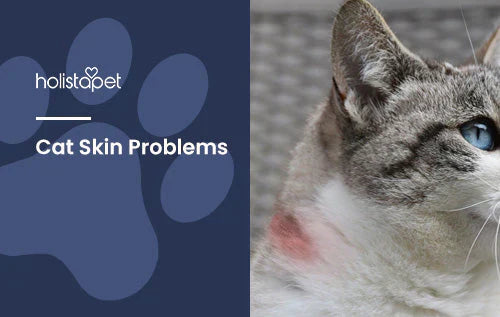Most of the time, our pet cats are adorable and cuddly companions, but sometimes they can be a little bit high maintenance. Have you ever noticed your cat itching or scratching a lot? If so, they may have cat skin problems. You might notice inflammation, hair loss, scabbing, flaking or even skin lesions.
Skin problems are one of the most common issues that cats face, and they come in many different forms. This article will look at some of the most common cat skin problems and discuss how you can manage them. So, if your cat is having skin issues, read on! We've got you covered.
Is It Normal for a Cat To Have Skin Problems?
One of the first things you'll want to ask yourself is whether cat skin problems are normal. The answer, unfortunately, is that it depends. Some cat skin problems are normal and can be caused by things like food allergies or environmental irritants. But other skin problems — like ringworm or cat acne — may be a sign of an underlying health issue.
If your cat is having skin problems, the best thing you can do is take them to the vet for a checkup. The vet will determine the root cause of the problem and prescribe the appropriate treatment.
What Causes Cat Skin Problems?
There are multiple factors that could lead your cat to experience itchy, irritated, or flaky skin. Some of these are health-related, but there are also many environmental factors at play. The most common causes of skin problems in cats include:
- Stress
- Poor grooming
- Reaction to medication
- Ringworm
- Cat acne
- Bacterial infections
- Ear mites
- Food allergies
- An underlying skin condition
In fact, even the plastic bowl you put out with their food or water can affect a cat's skin! Feline skin and fur is very sensitive. Even the type of bowl you serve their food and water in can cause skin issues. Some cats may have contact allergies to plastic!
Knowing what the cause of your cat’s skin irritation is the first step towards finding a solution. If you're not sure what's causing your cat's skin problems. If you still can't determine the problem, a veterinarian can answer any questions you may have. Let's take a closer look at each of these potential causes of cat skin conditions.
Stress
One common cause of cat skin problems is stress. Like humans, cats can experience anxiety and stress, leading to several health problems, including skin conditions. Many things can cause stress in cats, such as:
- Moving to a new home
- The addition of a new pet or family member
- Changes in their daily routine
- Being left alone for long periods
Poor Grooming
If your cat doesn’t groom sufficiently, it can lead to a number of skin problems. Cats are known for being high maintenance when it comes to their grooming habits, and if they don’t stay clean, they can become itchy and irritated.
One way to help reduce your cat's risk of developing skin problems is to groom them regularly. This means brushing their fur and cleaning their ears and teeth. It may seem like a lot of work, but it's worth it to keep your cat healthy and looking good.
Reaction to Medication
Cats can also experience skin problems as a reaction to medication. If your cat is taking any kind of medication, it's important to watch for any changes in their skin.
Ringworm
Ringworm is a fungal infection that can affect both humans and animals. It's called "ringworm" because it often appears as a circular rash on the skin. Ringworm is highly contagious, so if your cat has it, it's important to take them to the vet right away.
Cat Acne
Cat acne is a condition that affects the hair follicles of cats. It most commonly appears on the chin and lower lip area, and it can cause inflammation and irritation. Cat acne is often closely tied to grooming, so make sure your kitty is clean. However, it can also be affected by diet. If better grooming habits don’t solve the problem, try switching up their food.
Bacterial Infections
Bacterial infections are another common cause of cat skin problems. Things like Staphylococcus or Streptococcus bacteria can enter your cat’s body through contaminated food or water and cause skin infections, often resulting in inflammation and irritation.
Ear Mites
Ear mites are tiny parasites that can infect the ears of cats. They cause inflammation and irritation in the ear canal, which can be difficult to get rid of. If your cat has this problem, try dropping baby oil in their ears 2-3 times a day for about a month.
Food Allergies
Just like humans, cats can also be allergic to certain foods. If your cat eats a food that they're allergic to, it can cause skin problems. The most common food allergies in cats are dairy and wheat products.
An Underlying Skin Condition
Several underlying skin conditions can cause cat skin problems. These conditions include things like seborrhea, which is a condition that causes the skin to become dry and flaky.

Symptoms of Problematic Cat Skin
If you notice any changes in your cat's skin, or if they have any of the following symptoms, then it may be worth taking them to a veterinarian for advice.
- Excessive scratching or licking of the face, neck, or paws
- Red, inflamed skin
- Hair loss, bald spots
- Scaling or flaking of the skin
- Hot spots
- Crusty bumps
- Scabs
- Rashes
It's important to do your research and pay close attention to anything that may be affecting your pet.If they show any of the symptoms or behaviors we just mentioned, monitor their condition closely and take them to a vet if necessary.
Common Skin Problems in Cats
Cat skin problems are typically caused by things like scratching, food allergies, and other cat skin disorders. However, skin problems can also affect cats based on factors like their breed or lifestyle.Common skin problems include:
- Fleas
- Scabs
- Bald spots
- Allergic reaction or food allergy
- Feline acne
- Bacterial infection
There are various cat skin problems that you may encounter, but some are more common than others. Fleas, for example, are a very common cat skin problem, especially if your cat goes outside. Scabs and bald patches can also be symptoms of excessive scratching.
How To Prevent Cat Skin Problems
There are many things you can do to avoid skin problems in cats. Make sure you tend to these needs:
- Keep the environment clean
- Provide a nutritious, wet food diet
- Clean the litter box daily
- Ask a vet to test your cat for allergies
- Brush their coat regularly to remove dead hair and promote circulation
Home Remedies for Cat Skin Problems
There are plenty of remedies you can try at home if your kitty shows signs of irritated skin. Of course, if the problem is severe,you should take your furry friend to the vet. But if it's merely some itchy skin, try out some of the following home remedies first!
CBD
Cannabidiol (CBD) is a natural compound that can offer soothing relief from a variety of skin issues. CBD supports your cat’s endocannabinoid system (ECS), which plays a vital role in regulating the immune system. CBD also supports a calm state of mind, reducing worry, hyperactivity, and environmentally-induced distress, all of which can lead to skin irritation.
Omega-3 Fatty Acids
Omega-3 fatty acids are another natural approach to caring for cat skin problems. These healthy fats can help to reduce inflammation and moisturize the skin. They can also help reduce sebum production, which can lead to excess oiliness and greasy cat skin.
Vitamin E
Vitamin E is an antioxidant that can help protect the skin from damage. It can also help to moisturize the skin and reduce inflammation. Vitamin E is present in various foods, or it is also available as a supplement.
Aloe Vera
Aloe Vera is a natural plant that has many beneficial properties. You can use it to soothe inflammation and irritation in your cat, as well as to promote healing. You can apply Aloe Vera to your cat's skin topically, but you may want to invest in a cone if you do so. Aloe Vera is toxic for cats to ingest, and you don’t want them licking it off themselves!
Apple Cider Vinegar
Apple cider vinegar is a natural disinfectant that can help to kill bacteria and fungus. It can also help to reduce inflammation and irritation. You can apply apple cider vinegar topically to the skin or give it to your cat internally as a supplement (no more than a teaspoon).
Create a Safe Environment
One of the best ways to prevent skin issues in cats is to create a safe environment for them. Cats can often develop skin problems when they're feeling anxious or stressed. It's important to create a calm and relaxed environment for your cat. This may include providing them with a safe space, such as a cat tree or cat condo. And, of course, make sure to give your cat plenty of love and attention!
Regular Vet Checkups
Finally, it's important to take your cat for regular vet checkups. This will help to ensure that you catch any skin problems early and treat them effectively. Your vet will also recommend any additional measures that you can take to prevent cat skin problems.

Final Thoughts – Cat Skin Problems
Cat skin problems can be a common occurrence, but that doesn't mean you have to accept them as normal. There are many different causes of skin problems in cats, and you can prevent many of them with a few simple steps.
If your cat is experiencing skin problems over a long period and nothing you try helps, take them to the vet for an examination. With the right diagnosis and treatment plan, you can help your cat get back to feeling comfortable and looking great! For more information on cat care, check out our Blog section on our HolistaPet site.







![Probiotics For Dogs [Soft Chews] - HolistaPet](http://www.holistapet.com/cdn/shop/files/Probiotic-Infographic-1_472d7a29-e30c-435a-9638-1365d8c3a9f9.jpg?v=1725384841&width=104)



























Leave a comment
All comments are moderated before being published.
This site is protected by hCaptcha and the hCaptcha Privacy Policy and Terms of Service apply.